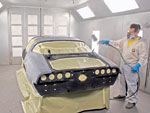
First impressions usually set the tone for how someone or something is perceived. In the automotive hobby, the exterior finish is usually what first attracts someone's eye. But how many actually have a grasp on current restoration trends within the hobby that affect what it takes to achieve award-winning, show-quality body and paintwork? Chances are, very few. So HPP approached a number of experienced restoration and supply specialists and asked them to answer the following questions. Here's what they had to say:
1.) Parts Car to Pristine
Question: As the number of unrestored Pontiac models diminishes and the values of rare vehicles skyrocket, has there been a decline in the initial quality of project vehicles?
Answer: Logic tells us that as the pool of unrestored vehicles gets smaller, the quality of available projects would surely decline. While other restorers may have noticed signs of that, Scott Tiemann of Supercar Specialties in Portland, Michigan, says he hasn't-yet.
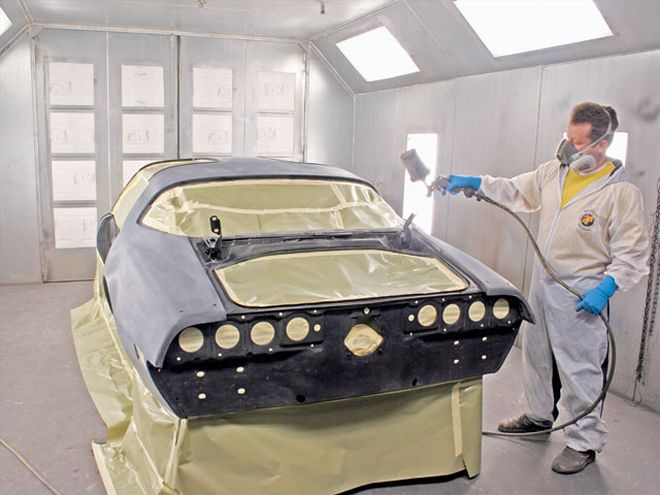 Painter Todd Otto of Restore A Muscle Car in Lincoln, Nebraska, applies a fresh basecoat to this Second-Gen Firebird.
Painter Todd Otto of Restore A Muscle Car in Lincoln, Nebraska, applies a fresh basecoat to this Second-Gen Firebird.
Tiemann is no stranger to restoring super-rare Pontiac models. His work has graced the pages of HPP on several occasions, and he tells us that there seems to be no shortage of clean, original Pontiacs to choose from. He does, however, agree that the base is getting smaller. "We get the occasional basket case," he says, "but good projects are still out there."
Having restored a number of high-end Pontiacs, Tiemann has had several arrive at his shop in boxes. "It seems that someone recognized the car's rarity, and started its restoration years ago. Then for some reason, usually lack of money or interest, the project stalled, and the car sat disassembled and unfinished. Since it has been off the road for a number of years, it's usually in pretty good shape. We just hope that the rare parts are still with it."
When asked if a project that was beyond restoring has come into his shop, Tiemann replied, "Depending on its rarity, anything is salvageable. If we can't find N.O.S. panels for it, we can repair the originals or cut others from a donor. We can even make our own or use reproductions if necessary." He did, however, say, "If a customer brings us a garden-variety GTO for restoration and it's too far gone, we usually suggest starting with another from an economic standpoint."
Tiemann offers a bit of advice for hobbyists searching for restoration candidates: "Start with a good base, it'll save you in the long run." But he also suggests taking detailed pictures of the disassembly process. "The photos can be used to document original finishes and help during reassembly." Tiemann also says that past articles of correctly restored Pontiacs make excellent reference materials when trying to determine the correct finish on specific components or hardware.
2.) Panel Pondering
Question: Since the supply of N.O.S. and good, used original body panels continues to diminish, has there been a steady increase in the use of reproduction panels?
Answer: While some suppliers produce near-exact reproductions of original GM body panels for certain Chevrolet applications, there seems to be less of a selection for Pontiacs. Based on our past experience with some of them, it has sometimes seemed wiser to repair the existing original. Happily, there are restoration companies that actually rate the panels in their catalogs and provide descriptions of the typical work needed to get them to show quality. And let's not forget that there are some very good reproductions out there, and that many of those that have been less so, have improved over the last few years.
Looking for a professional opinion on the subject, we contacted Paul DiMauro of Pro1 Custom/Rods and Restorations in Deer Park, New York. DiMauro's shop typically has over 20 restorations in progress at any given time, and his work has been featured in HPP.
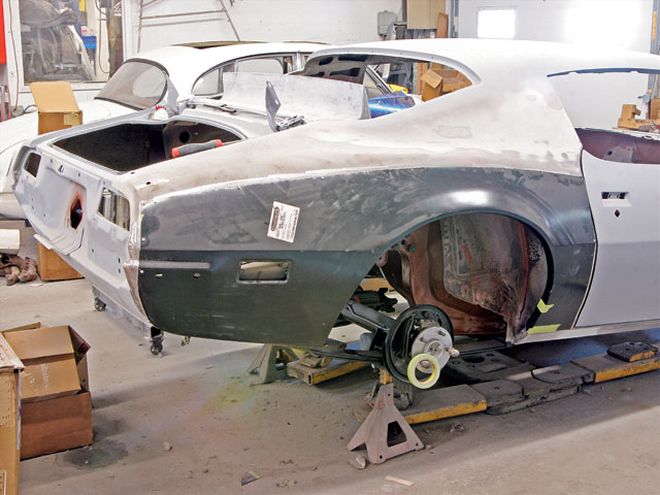 Photographed at Chalek's Auto Body, this reproduction Pontiac body panel is a quarter-skin. As such, it doesn't extend into the sail panel, doorjamb, or rear body-panel areas, which can be viewed as an advantage or disadvantage depending upon the condition of the project car.
Photographed at Chalek's Auto Body, this reproduction Pontiac body panel is a quarter-skin. As such, it doesn't extend into the sail panel, doorjamb, or rear body-panel areas, which can be viewed as an advantage or disadvantage depending upon the condition of the project car.
Upon hearing the question, DiMauro replied, "Longevity and the end result are our greatest concerns, so we want to maximize metalwork to minimize body-filler work. We'd prefer to use a vintage N.O.S. panel as a replacement for an unsalvageable piece, but there are so few out there. Used originals aren't really an option either due to the fact that the cars once considered donors are now being restored. So we try to repair original body panels using custom-made patches, but we've also used reproductions depending upon the application."
The limited number of reproduced Pontiac body panels currently on the market leaves many restorers in a bit of a quandary. DiMauro says that from an economic view, installing a reproduction panel is sometimes more costly than repairing an original. "Depending upon the vehicle, the quality of the reproduction body panels can be good. But we've also seen situations where we had to section them just to fit body lines." He is quick to say, however, that not all panels are problematic. "Structural panels, such as the trunk floors and floorpans, are quite good and usually require the least amount of fitting."
When asked which popular Pontiacs seem the toughest to restore DiMauro, replied, "It has to be the '68 GTO. Rust-free '68 decklids are like gold, and the '66 and '67 GTOs aren't far behind. But the '68s have to be the toughest right now. It seems like everything is unique, and nothing is available."
3.) Glue It!
Question: With structural adhesive widely used by auto manufacturers to attach body panels on today's vehicles, is it an option when installing new panels on vintage Pontiacs. Does it offer any advantages or disadvantages over traditional welding?
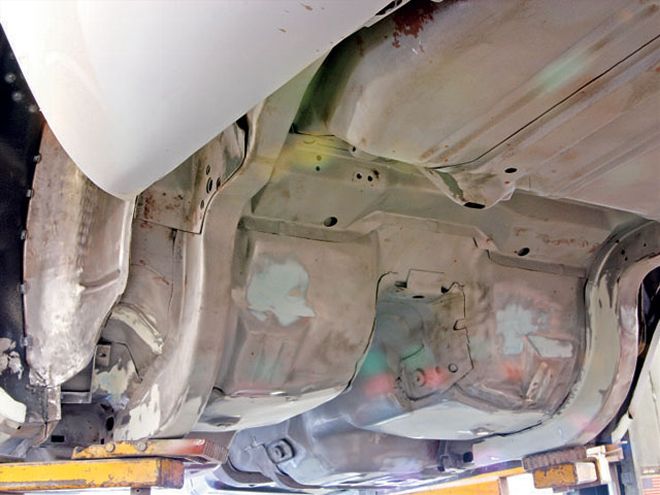
Answer: General Motors began using structural adhesive on vehicles in the early '90s. Anyone familiar with Firebird models produced during that time can testify to its benefit. In addition to normal welding, the body panels of these models were literally "glued" together, significantly increasing body rigidity and subsequently improving overall build quality.
Since so many new vehicles are built with composite panels, structural adhesive has replaced welding in a number of areas. In many instances, it is used to bond metal panels, too. Wanting to know if structural adhesive is compatible with vintage Pontiacs, we contacted Melvin Benzaquen of Classic Restorations in Pine Island, New York. You may recognize Benzaquen's name from his longtime relationship with HPP as a contributor, but anyone who has seen examples of his work knows that his credentials speak for themselves.
Benzaquen tells HPP that using two-part, epoxy-based structural adhesive to install new body panels has a number of advantages. "We've used it for years without any negative effects. It's widely employed by auto manufacturers today, and '06 crash standards far exceed those of 20 years ago. So that says something about it. But it's also less hazardous than welding, and there is no initial cash outlay to purchase a high-quality welder, welding wire, and gas," he says.
Unlike welding, which can require a lengthy learning process, using structural adhesive is fairly straightforward. It has made fitting body panels easier for restorers, too. "It gives us a little time to adjust the panel while the epoxy sets," says Benzaquen. "And since we aren't heating the metal by welding, there is no metal shrinkage or warping to contend with. That means there is far less grinding to clean welds and smooth body joints, which can translate into cost savings for the customer."
4.) Vintage Sheen
Question: What products available today most closely replicate a Pontiac's original finish, and is durability compromised in any way?
Answer: Anyone who has purchased a vintage Pontiac when new knows that very few vehicles left the factory sporting a mirror-like finish that was blemish-free or without an area of sparse coverage. That means replicating these flaws during a restoration could be considered correct. But since points are not deducted for clearcoated or wet-sanded finishes at points-judged Pontiac gatherings, many owners forego the original appearance and opt for basecoat/clearcoat to give their Pontiac as much luster as possible.
Dave Chalek of Chalek's Auto Body in Bellevue, Nebraska, has been restoring vehicles in his shop since 1989. He learned the technique of flawless paint application working alongside his dad, Bob Sr., from a young age. Anyone who has seen the family's work knows how seriously they take the art of paint and bodywork.
Chalek says that the original finish found on most vintage Pontiacs was lacquer-based. While the availability of lacquer is severely limited today, he feels that the removal of lead from it in recent years has also compromised its durability. "Single-stage urethane with minimal sanding and/or buffing most closely resemble the lacquer finish applied by Pontiac," says Chalek.
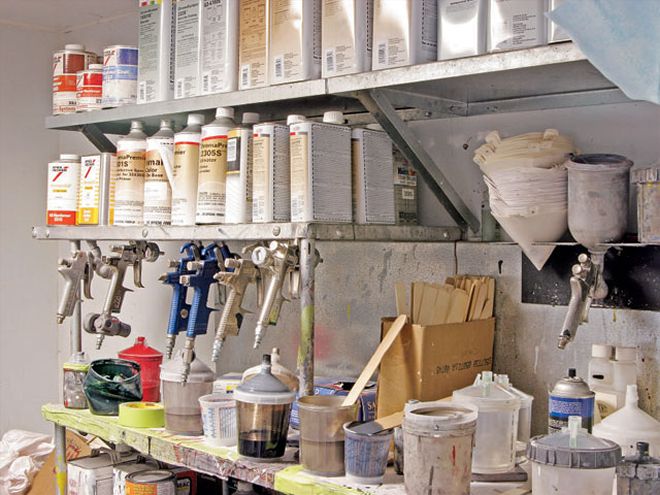 With the amount of toxic chemicals found in automotive paints, preventing inhalation should be of utmost concern. Be sure to check your local governing laws before spraying of any kind.
With the amount of toxic chemicals found in automotive paints, preventing inhalation should be of utmost concern. Be sure to check your local governing laws before spraying of any kind.
Like lacquer, single-stage urethane metallic colors can be difficult to work with. "They can streak or leave blotches," Chalek says. He went on to say that this was a fairly common occurrence when the paint level in the siphon can of the older siphon-fed paint guns got low. But with today's gravity-fed high-volume/low-pressure (HVLP) guns, the situation has greatly improved.
"We prefer to use basecoat/clearcoat when restoring vehicles," Chalek says. "It provides a high gloss and gives the finish lots of depth. But base/clear doesn't necessarily offer additional durability over a single-stage finish." It does, however, have advantages when spot repairs are required. "Unlike a single-stage where an entire panel must be painted, we can usually apply base color to the blemish and then blend the clear into the panel, making the repair practically undetectable," he adds.
Chalek notes that modern finishes are very durable and not nearly as vulnerable to the elements as the originals. They are also virtually maintenance free. After the initial wet-sanding and buffing, they require normal polishing to maintain their luster once the 90-day curing period has elapsed. Unlike a lacquer finish, however, scratches must be removed using a high-speed machine buffer.
5.) Homework
Question: What suggestions can an experienced restorer offer to a hobbyist regarding entering the restoration field, starting a restoration business, or restoring a Pontiac at home?
Answer: As values increase on a daily basis, it seems as if everyone hopes to take advantage of the musclecar-market boom. This has created a gross misuse of the term restored. At Jim Mott Restorations in Twin Falls, Idaho, no truer a word is spoken. Mott's work has been featured in HPP and is second to none. With just one look at what rolls from his shop, you'll quickly understand the true meaning of a total restoration.
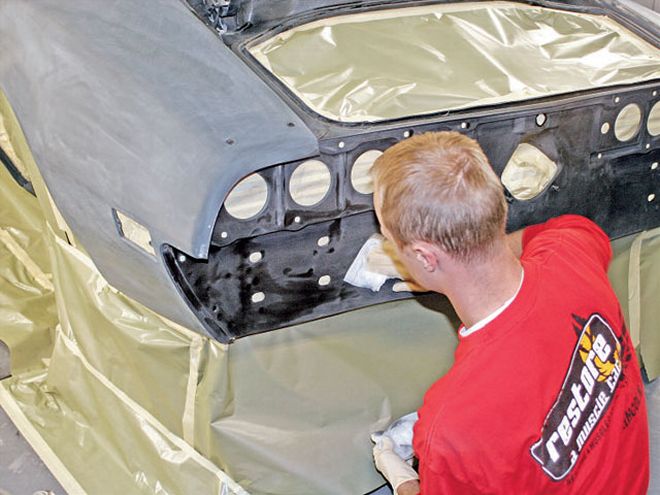
This question was directed towards Mott because he is an independent restorer with a small shop located in his backyard. He doesn't have a staff of employees that specialize in certain areas of restoration, and rarely has he found a component of the body or drivetrain that he was unable to fix himself. Simply stated, Mott does it all and he does it well.
Mott's first suggestion for newcomers is to keep expenses to a minimum. "It doesn't pay to have a huge shop right from the start. It usually means big bills and high overhead. You'll never begin making money that way," he says. "Start as small and as cheap as you can, even if it means working from a two-car garage. A square jig and rotisserie are great assets when space is tight."
Developing a reputation in an area where a waiting list exists can be very difficult. Mott has found that for a small shop, a true restorer has to perform all the work himself. "You have to be a master mechanic that can assemble and tune engines, set up transmissions and rear gears, and track down electrical problems. But you also have to be equally experienced in paint and bodywork. It's the jobs you farm out, when you become responsible for another person's work, that can get you into trouble."
Mott has found that very few rust-free original projects exist anymore. "Today we must adapt to the situation of restoring parts cars," he says, and in his business, he refuses to use reproduction body panels. Instead, he travels to the West Coast several times throughout the year and gathers original body panels with minimal rust to maintain a complete inventory. His opinion is that without original sheetmetal, a restoration is compromised.
6.) Home-Painter Legalese
Question: Have there been any recent changes to paint formulation that affect the hobbyist who plans on restoring his Pontiacs at home?
Answer: Numerous rumors of late suggest hobbyists will no longer be able to purchase paint from local automotive-paint suppliers, and it isn't any secret that lacquer-based paints are virtually nonexistent. But what about the future of enamel paint? And how about the legality involved with painting your car at home?
To confirm or dispel some of these rumors, as well as gauge current hobby trends, we contacted Ron Stazzoni of D&R Auto Paint and Supply in Omaha, Nebraska. With over 20 years experience in the industry and as the area's only licensed PPG-supplier, we were confident that Stazzoni could shed a great deal of light on the topic.
Stazzoni started by saying, "Enamels and lacquers are going away. Replacing them are high-solid, low-VOC (volatile organic compound) urethanes. These are much more technical and have less room for error, which will make it tougher for the home restorer. The good news is that they have great durability and can produce fantastic results when applied correctly. In 2008, water-borne products will begin appearing in California. Anyone will be able to purchase them, but their use may be too technical for the average hobbyist."
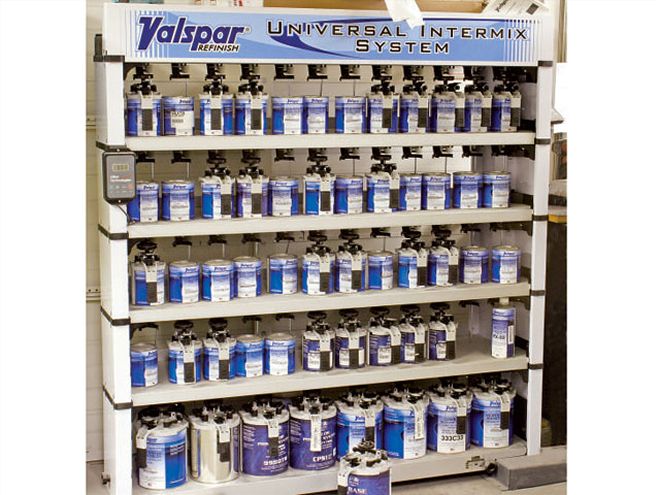 Urethane-based, high-solid/low-VOC paints will soon replace virtually all lacquer- and enamel-based paints, according to our experts.
Urethane-based, high-solid/low-VOC paints will soon replace virtually all lacquer- and enamel-based paints, according to our experts.
When asked if he has seen an increase in home restorations, Stazzoni replied, "Yes, we have. Current television shows may have sparked that trend. They make it seem so easy."
Another facet that may fuel this trend is high restoration costs. "People usually get an estimate from a body shop. After getting over the shock, they decide to try it themselves. But once they get into the project, they quickly realize why shops charge so much," he added.
Stazzoni's company offers a number of different paint systems for home hobbyists to choose from. "PPG's Shop Line is one of the newest," he says. "It contains a high-quality resin base at an affordable price. When you consider that a restoration can cost thousands of dollars and that the finish is the first thing a spectator sees, saving a few hundred dollars buying a cheaper system isn't always the best option."
A common area of concern amongst hobbyists is the legal guidelines for painting at home. While thoroughly researching local laws before painting is strongly suggested, "around here, any area over 24-inches square is supposed to be painted in an approved booth," Stazzoni says. "There can also be huge fines for improper disposal of the hazardous waste that is produced. The fumes contain harmful products that can cause serious respiratory problems when inhaled. So investing in a paint respirator is also a good idea."
Conclusion
While there are certainly an infinite amount of questions we could have asked our group of experts, their answers cover a broad spectrum regarding the current state of the hobby as well as its future. Since they are so closely related to the industry, we're confident they are on the cutting edge of current trends. So no matter how you perceive automotive restorations and paint and body in particular, like any other facet of the hobby, it too is constantly changing. If we as hobbyists don't adapt, there's little hope for our future.